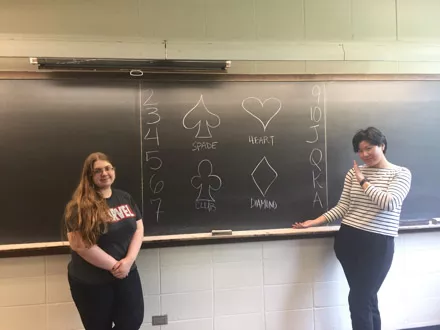This article appeared in the Fall 2017-Spring 2018 Bryn Mawr Math Alumnae Newsletter.
Fish is a time-honored tradition of the Distressing Math Collective (DMC), the beloved math club at Bryn Mawr. It is played every Thursday after the weekly talk, so long as enough people stay to play. All you need are six willing participants (victims?) and a standard deck of cards. (Bonus points are awarded if the deck has owls on it, but this is not necessary.)
Set-Up: The first order of business is to divide the players into two teams of three people each. In order to choose teams, have each person draw a card from a face-down deck. The three people with the highest cards are on one team, and those with the lowest cards are on the other team. Before the game begins, remove the four eights from the deck and shuffle the remaining cards well. By taking out the eights, you will be left with eight half-suits, comprised of the low cards (2, 3, 4, 5, 6, and 7) and the high cards (9, 10, J, Q, K, and A) from each suit (clubs, diamonds, hearts, and spades). The goal of Fish is to collect as many half-suits as possible for your team.
Gameplay: The dealer divides the shuffled deck (without the eights, of course!) evenly between the six players. The player who drew the highest card when choosing teams asks the first question. The goal for each player is to collect as much information as possible about what cards and half-suits are in everyone else’s hands. A player may ask for another player’s card if: (1) the card the player is asking for is a member of a half-suit the player already has in her hand and (2) the card is not one that the player already has in her hand.
Illegal questions occur when one of the above rules is broken; oftentimes, players will get so caught up in the back-and-forth trading of cards in a half-suit that they will continue that line of questioning, despite not having a card in said half-suit. If an illegal question is asked but realized before the opponent had a chance to answer, then the asker may ask a different question. If, however, the illegal question was asked and answered and then realized, then the questioning switches to the opponent who was asked the illegal question and game-play continues as normal.
Honesty is key in this game! If a player has been asked for a card that she has, then she must give it up. One player continues asking individual players on the other team for cards until one of the opponents does not have the card she’s been asked for. At this point, the question asking passes to the most recent player to be asked for a card. A player either wants to collect as much of a half-suit as possible or to pin down the locations of every card in the half-suit on her team. Once the player either collects an entire half-suit in her own hand OR knows the exact location of each of the other cards in the half-suit, that is, which of her teammates has each card, then the player can make a claim.
A claim is an assertion that a player knows not only that her team has an entire half-suit between them, but also exactly which cards of the half-suit she and each teammate is holding. Don’t take claims lightly! Only make a claim when you know that the full half-suit is on your side and when you know which person has which card. Claims may be halted up until the first card number is pronounced; as soon as you claim to have, for example, the two of hearts, then you must continue your claim even if partway through you realize that you have made a mistake. If, however, a player stops before saying a card number or suit, then the claim can stop and regular game play continues. If a claim is made incorrectly, then the other team gets that half-suit no matter who had the cards of the half-suit the claim was made for. Claims are how teams win or lose games. The team that has correctly claimed the most half-suits wins. Do not make a claim if you are not 100% sure that you know which team member has which card, or else you will disappoint your team with your folly.
A few other game mechanics to note are the “pause button” and the “no history” rules. The “pause button” allows players to pause the game when they need to think through something (such as when a player needs to get her strategy in order or do some math in her head without the hustle of game play in the background). Using the “pause button” allows players a time to focus on the cards and previous questions they can recall without having to keep refocusing on the questions being called back-and- forth at the same time. Often, since we are math majors, we think we reach contradictions because someone asked an illegal question: either they had the card they asked for or they did not have a card in the half-suit they asked for. Working out when these questions have been asked (and by whom) is just another level of difficult fun that Fish will throw at its players. The “no history” rule states that the game only remembers the most recently asked question. Players cannot ask about any previous questions, not even to clarify which card was asked for or if the asker received it. Players should always be paying attention! Once the information is gone, if it isn’t in your noggin, then it’s gone for good!
That is just a quick roundup on how to play a favorite DMC tradition. Feel free to try it out at home! Most importantly, have fun with it!

